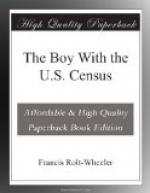“Come back at two o’clock, then,” said the manager. “One of the members of the Board, Mr. Nebett, is here to-day, and if he has no objection I’ll try to find some one to show you round.”
Promptly at the appointed hour, Hamilton handed his card to the doorman, who showed him into a waiting-room. In a few minutes the door opened, and a keen-looking, well-set-up man appeared who came forward and held out his hand.
“I’ve been hearing about you from Mr. Arverne,” he said, “and he tells me that you want to look over the works.”
“Mr. Nebett?” queried the boy, and in response to an affirmative nod, he continued, “Yes, sir, I’m very anxious to see part of it at any rate. I can see that it’s a huge place, but gun-making must be so interesting that I’d like to see how it’s done.”
“I think Mr. Arverne said something to me about your writing up a special report, a summary or something of that kind.”
“That was just a suggestion, Mr. Nebett,” the boy replied. “I told Mr. Arverne that the Census Bureau did issue special bulletins on selected industries, and that perhaps I might have an opportunity to make use of some information. But that’s a personal idea of mine only, because most of those bulletins are written by experts in the Bureau.”
“Well,” was the reply, “I don’t see that it can do us any harm, anyway, and if you are so interested you can come along with me. I like to go through the works every once in so often, and perhaps I can tell you more about these things than any other man in the place, because I get a chance to see it as a whole.”
“If you would,” began the boy.
“Come along, then,” said the official, without further parley, and he led the way out of the general offices and across the street to the first of a huge group of buildings. Walking through the yard the two came presently to a long structure running alongside the railroad sidings. “This,” Hamilton was informed, “is just the storeroom for raw material as it comes off the cars.”
He turned half round as though to leave the building, but Hamilton stopped him with a question.
“Steel, principally?” he asked.
“Steel.”
“What kind of steel?” persisted Hamilton.
“Oh, different kinds.”
“Why different kinds?” continued the boy, working his eyebrows, as was his habit when in earnest. “For different kinds of guns?”
“Yes,” answered the older man, evidently deciding that he would have to go into the matter thoroughly with Hamilton, and passing on into the storehouse. “We get mostly three kinds of steel, nickel steel, carbon steel, and soft steel, with a small proportion of other forms. We do that for the very reason you mentioned, that they are used for different kinds of work. Nickel steel we do not use for the cheaper grades of guns, because it is so much harder, and costs so much more to work. Indeed, very few gun-makers use nickel steel for barrels at all, but we do on all our high-grade work.”




